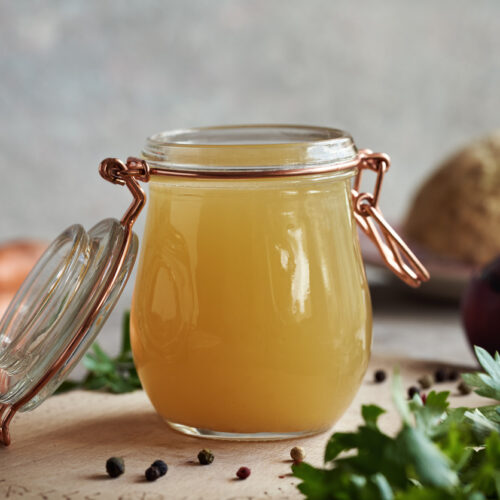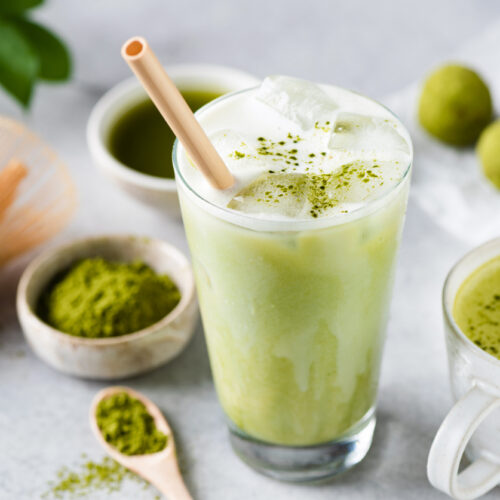
Whether you’ve got a converted family member or a vegan friend coming for dinner, nutrition editor Amanda Ursell’s round-up of plant-based proteins and vegan meat alternatives that aren’t ultra processed will inspire confidence about meat-free cooking
‘I’m going vegan‘. These words are enough to strike fear into the heart of any omnivorous family cook, who suddenly finds their tried and tested mode of preparing meals outlawed with one stark pronouncement.
After the initial panic over potential diet deficiencies comes the stress of creating a shopping list with curious-sounding ingredients suggested by zealous offspring. Out goes beef mince spag bol, and in comes seitan spag bol. Forget the tuna – it’s time to tackle tempeh. What with demands for jackfruit, banana blossom and teff, you could be forgiven for downing tools and heading to the pub for a G&T and a pack of peanuts to gather your thoughts on what the heck to do next.
One option is to take the stance of a friend’s mother, who simply told her newly converted daughter, who was about to show up for dinner: ‘Darling, I don’t do vegan.’
‘Have you got beans on toast?’ asked Charlotte.
‘Of course,’ came the reply.
‘Then you do “do” vegan, Mum.’
This apparently sparked an interest and now Charlotte enjoys many a vegan meal with her mother, frequently finding herself being severely warned over the perils of ‘dirty veganism’, which, she is informed, is bad for the environment and your health.
‘It’s astonishing,’ says Charlotte. ‘She’s ahead of the game in every way, sourcing new ingredients and deriving a great deal of satisfaction from polishing her eco-friendly diet credentials whenever we meet.’
So it’s not all bad news. If, like Charlotte’s mother, you take the ‘if you can’t beat them, join them’ approach, cast your eyes over the following pages. We give you the low-down on the pluses and minuses of vegan alternatives, along with tips for what on earth you’re supposed to do with them.
Vegan protein alternatives and ‘meaty’ fruits
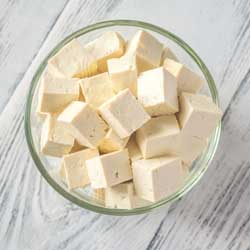
1 Tofu
What is it? Tofu is a white curd made from soya beans that are soaked, ground with water, boiled and then filtered to produce a warm ‘milk’. To this, a curdling agent such as calcium sulphate is added. The resulting curd is transferred to boxes where, as with cheese-making, the whey-like liquid is squeezed out, leaving the tofu behind to set.
What can you do with it? Plain tofu can be soft to moderately firm or firm. The soft version is best for making smoothies and dips, for example, while the firmer versions work well in stir-fries or threaded on to kebabs.
Any drawbacks? With all the flavoured or smoked tofu products available, you’ll need to check nutrition labels to be sure that salt, sugar and fat levels don’t soar after the extra processing they’ve undergone.
Per 100g plain steamed tofu l 75kcal l 8.1g protein l 4.2g fat l 0.5g saturates l 0.7g carbs l 0.3g sugars l 1.3g fibre l 0g salt
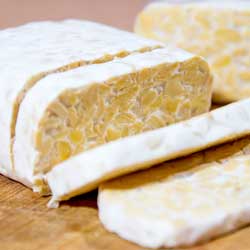
2 Tempeh
What is it? Tempeh is made with whole soya beans, which are soaked, stripped of their hulls and partly cooked. A fungus is then added and the mixture is spread into layers, which are left for around 24 hours to ferment. The long filaments produced help bind the beans to create a solid ‘cake’. After 48 hours, the tempeh is ‘harvested’. It has a higher nutritional content than tofu, with more than double the protein and substantially more B vitamins.
What can you do with it? Marinate it at home and eat on its own, use in stir-fries, soups and stews or grate for a sandwich filling. It’s available flavoured or smoked in cans, or unflavoured – either minced, in long-life packaging, or sliced, in jars.
Any drawbacks? When mixed with a coconut sauce, for example, saturated fat content can rise to 5g per serving, while ‘bacon’ versions can have around 1g salt per 100g.
Per 100g serving l 173kcal l 20.7g protein l 6.4g fat l 0g saturates l 5.9g carbs l 0.9g sugars l 3.3g fibre l 0g salt
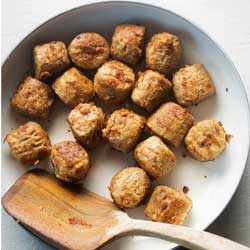
3 Vegan Quorn
What is it? Quorn is a branded vegetarian product, which contains almost 90% mycoprotein, a type of fungus. Egg white is added to the standard version, so you’ll need to look for the vegan variety. This has some potato protein mixed in with the mycoprotein, along with additives that help make it firmer, including calcium chloride, wheat gluten and pea fibre, plus stabilising ingredients such as carrageenan. Vegan Quorn is high in protein and fibre and low in saturated fats.
What can you do with it? Plain Quorn pieces can be used in curries and casseroles, stews, soups and stir-fries.
Any drawbacks? It’s not suitable for people who avoid gluten. Quorn sausages, burgers and breaded fillets can have up to 1.4g salt per serving and 4g saturated fats, so you’ll need to be vigilant and check the labels.
Per 100g serving plain Quorn pieces l 113kcal l 15.3g protein l 2.8g fat l 1g saturates l 3.9g carbs l 0.4g sugars l 5.3g fibre l 0.4g salt
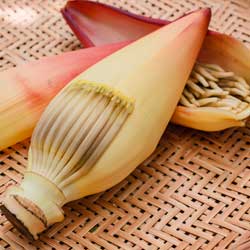
4 Banana blossom
What is it? As the name suggests, banana blossom grows at the end of a cluster of bananas. It is a fleshy, purple-skinned flower, shaped like a teardrop. Inside the flower is the heart, which has the texture of cooked tuna and absorbs flavours quickly and easily. Popular in southeast Asian and Indian cooking, it provides a meaty consistency and can be made to taste like animal proteins.
What can you do with it? Soak pieces in fish stock and wrap in nori sheets, stir-fry chunks, or dice and use instead of mince.
Any drawbacks? While it can be used in place of meat, chicken or fish in main-course dishes, banana blossom is low in protein, at only 1.5g per 100g serving, so it shouldn’t be viewed as a straight swap nutritionally.
Per 100g serving l 23kcal l 1.5g protein l 0g fat l 0g saturates l 3.8g carbs l 0g sugars l 0g fibre l 0g salt
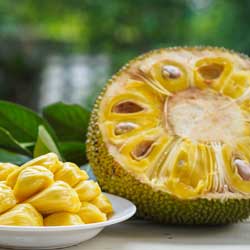
5 Jackfruit
What is it? The largest edible fruit in the world, jackfruit is currently grown in tropical climates. Both the seeds and fruit can be eaten, but it’s the fruit that has recently grown in popularity among vegans because its texture when cooked is similar to pulled pork, making it a good substitute for meat. Jackfruit is rich in the yellow antioxidant pigment lutein, which has been linked with eye health as we age, helping to protect the macular from the damaging rays in sunlight.
What can you do with it? Jackfruit can be eaten unripe if it’s cooked. Once ripe, it can be eaten like a fruit – or it can be cooked and made into desserts.
Any drawbacks? It’s only 6% protein, with less than 2g per 100g, compared with 7g for the same weight of soy-based tofu, so isn’t suitable for use as your main protein source.
Per 100g serving l 101kcal l 1.5g protein l 0.3g fat l 0.1g saturates l 22.4g carbs l 0g sugars l 1.6g fibre l 0g salt
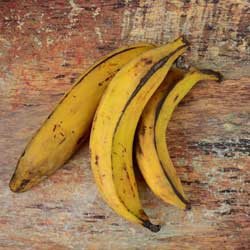
6 Plantain
What is it? This relative of the banana is usually eaten cooked (either unripe, while the skin is still green, or ripened, with the skin either yellow or turning black). The fruits contain more starch and less sugar than traditional eating bananas but tend not to be as tasty. Plantain gives us vitamin C and is a source of vitamin B6, folate and potassium.
What can you do with it? Plantain can be boiled, baked, microwaved, grilled, steamed or fried, either peeled or unpeeled. Use in stews, casseroles and soups along with pulses such as black-eyed beans to up the protein content. Boiled plantain works particularly well with avocado.
Any drawbacks? Sap from the peel and even the fruit itself can stain clothing and hands – it’s hard to remove, so be careful! As with the other fruit here, plantain is low in protein.
Per serving l 120kcal l 1.1g protein l 0.3g fat l 0.1g saturates l 27.1g carbs l 5.5g sugars l 2.3g fibre l 0g salt
For more on veganism, you might be interested in: Vegan, vegetarian and plant-based – what are the differences?
www.healthyfood.com


